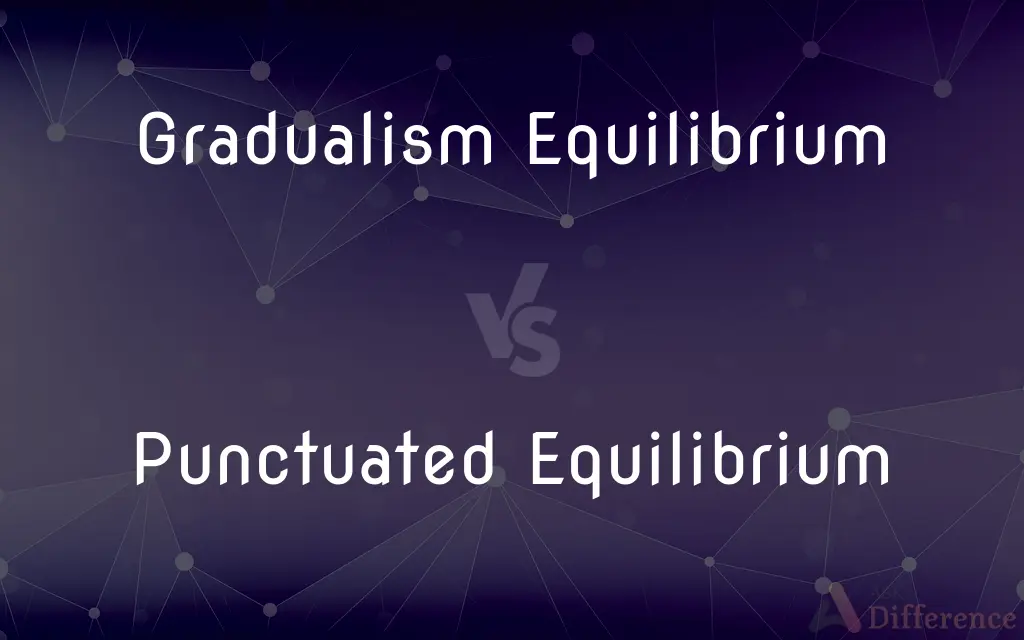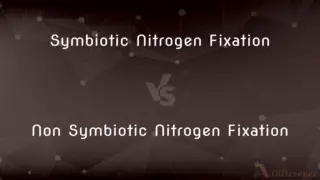Gradualism Equilibrium vs. Punctuated Equilibrium — What's the Difference?
Edited by Tayyaba Rehman — By Fiza Rafique — Published on December 21, 2023
Gradualism Equilibrium suggests evolutionary changes occur slowly and steadily, while punctuated Equilibrium proposes long periods of stasis punctuated by rapid bursts of evolution.

Difference Between Gradualism Equilibrium and Punctuated Equilibrium
Table of Contents
ADVERTISEMENT
Key Differences
Gradualism Equilibrium posits that species undergo small, consistent changes over long periods, leading to evolutionary adaptation. Conversely, punctuated Equilibrium argues that most species experience long periods of little to no evolutionary change, interrupted by short, intense bursts of evolutionary activity.
In the Gradualism Equilibrium model, the pace of evolution is likened to a slow, continuous march. In contrast, the punctuated Equilibrium model likens evolution to a series of fits and starts, with long pauses between significant changes.
Advocates of Gradualism Equilibrium believe that the fossil record's gaps result from incomplete data. However, supporters of punctuated Equilibrium interpret these gaps as evidence of rapid evolutionary events followed by prolonged stability.
Gradualism Equilibrium suggests a steady transformation where one species morphs into another over vast timescales. On the other hand, punctuated Equilibrium envisions scenarios where species remain stable for long durations and then quickly branch into new species.
Charles Darwin's original conception of evolution leaned more towards Gradualism Equilibrium, emphasizing gradual change. In contrast, punctuated Equilibrium was introduced in the 1970s by paleontologists Niles Eldredge and Stephen Jay Gould, highlighting the disparity in the fossil record.
ADVERTISEMENT
Comparison Chart
Rate of Evolution
Slow and consistent changes
Rapid changes with long periods of stasis
Evolutionary Patterns
Steady transformation
Fits and starts with significant changes
Interpretation of Fossil Record
Gaps due to incomplete data
Gaps indicate rapid evolutionary events followed by stability
Origin
Associated with Darwin's original conceptions
Proposed by Niles Eldredge and Stephen Jay Gould in the 1970s
Speciation Mechanism
Species morph slowly over time
Species remain stable and then quickly branch into new ones
Compare with Definitions
Gradualism Equilibrium
Constant evolutionary transformations over vast timescales.
Some argue the evolution of the horse fits the Gradualism Equilibrium model.
Punctuated Equilibrium
Evolution marked by fits, starts, and long pauses.
Some believe the evolution of birds from dinosaurs happened in a manner consistent with punctuated Equilibrium.
Gradualism Equilibrium
Evolution characterized by slow, incremental changes.
The development of antibiotic resistance in bacteria is often cited as a real-world example of Gradualism Equilibrium.
Punctuated Equilibrium
Evolutionary model of rapid changes followed by stasis.
The sudden appearance of many animal forms in the Cambrian Explosion aligns with punctuated Equilibrium.
Gradualism Equilibrium
Steady adaptation due to consistent environmental pressures.
The adaptation of the peppered moth in industrialized England exemplifies Gradualism Equilibrium.
Punctuated Equilibrium
Quick speciation events followed by evolutionary stasis.
The sudden appearance and diversification of flowering plants in the fossil record might be explained by punctuated Equilibrium.
Gradualism Equilibrium
A theory of slow, continuous evolutionary change.
Darwin's finches may represent an example of Gradualism Equilibrium.
Punctuated Equilibrium
A model emphasizing disparity in the fossil record.
The relatively rapid rise of mammalian species after the extinction of dinosaurs can be seen as evidence for punctuated Equilibrium.
Gradualism Equilibrium
A model suggesting smooth evolutionary transitions.
The slow development of resistance among pests to certain pesticides can be viewed through the lens of Gradualism Equilibrium.
Punctuated Equilibrium
Long periods of stability interrupted by evolutionary bursts.
The rapid divergence of cichlid fish species in isolated African lakes is a case for punctuated Equilibrium.
Common Curiosities
What's the primary difference between Gradualism Equilibrium and punctuated Equilibrium?
Gradualism implies slow consistent changes, while punctuated suggests rapid bursts of change interspersed with stasis.
How does each theory interpret gaps in the fossil record?
Gradualism sees them as data incompleteness, while punctuated views them as real, indicating rapid evolutionary events.
Which model is most associated with Darwin's original ideas on evolution?
Gradualism Equilibrium.
How does Gradualism Equilibrium view the rate of evolution?
It sees evolution as slow, steady, and continuous.
Who introduced the concept of punctuated Equilibrium?
Niles Eldredge and Stephen Jay Gould in the 1970s.
Share Your Discovery

Previous Comparison
Symbiotic Nitrogen Fixation vs. Non Symbiotic Nitrogen Fixation
Next Comparison
Pure ALOHA vs. Slotted ALOHAAuthor Spotlight
Written by
Fiza RafiqueFiza Rafique is a skilled content writer at AskDifference.com, where she meticulously refines and enhances written pieces. Drawing from her vast editorial expertise, Fiza ensures clarity, accuracy, and precision in every article. Passionate about language, she continually seeks to elevate the quality of content for readers worldwide.
Edited by
Tayyaba RehmanTayyaba Rehman is a distinguished writer, currently serving as a primary contributor to askdifference.com. As a researcher in semantics and etymology, Tayyaba's passion for the complexity of languages and their distinctions has found a perfect home on the platform. Tayyaba delves into the intricacies of language, distinguishing between commonly confused words and phrases, thereby providing clarity for readers worldwide.













































